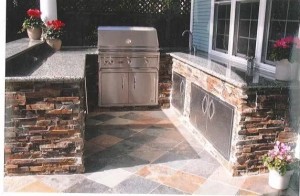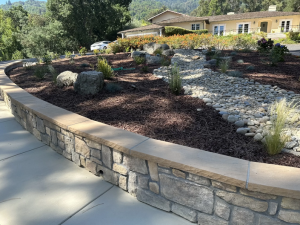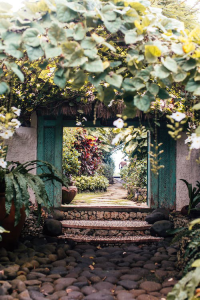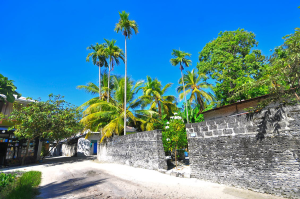
The outdoor design stands as an essential canvas for enhancing curb appeal and setting the tone for a welcoming home while maintaining residential aesthetics. Amidst this artistic landscape, the often-overlooked yet vital players are retaining walls. These structural wonders not only defy gravity but also infuse landscapes with strength and style.
In this guide, let’s embark on a journey into the world of retaining walls, uncovering their pivotal role in outdoor design. Exploring their multifaceted significance, we’ll delve into various types, design considerations, and the seamless integration of functionality and aesthetics they offer in landscaping. Join us as we unveil the profound impact of retaining walls in crafting enduring and visually captivating outdoor spaces.
Understanding Retaining Walls
Retaining walls are essential structural elements in landscaping, designed to restrain soil and shape landscapes. These walls prevent the lateral movement of soil, retaining it in place against the force of gravity. They come in various materials, such as concrete, stone, timber, or modular blocks, catering to diverse aesthetic and functional needs in outdoor design.
Purpose in Landscaping
The primary purpose of retaining walls is to prevent soil erosion and create terraced landscapes. By holding back soil on slopes, these walls mitigate the risk of erosion caused by water runoff or gravitational pull. They effectively manage soil movement, preventing the loss of valuable topsoil, particularly in areas prone to erosion.
Importance in Preventing Soil Erosion
Retaining walls act as guardians against the erosive forces of water runoff and gravitational pressure. They provide structural support to prevent soil from sloughing off, preserving the integrity of landscapes. These walls offer stability to hillsides, preventing landslides and maintaining the original contours of the land.
Creating Terraced Landscapes
One of the significant roles of retaining walls is in creating terraced landscapes. By structuring multiple levels, these walls maximize usable space on sloped terrain, transforming steep slopes into functional, tiered areas for gardens, seating, or walkways. Terraced landscapes offer both visual interest and practicality, allowing for creative landscaping and aesthetic diversity.
Retaining walls, through their structural integrity and landscaping prowess, play a crucial role in preserving soil, preventing erosion, and creating visually appealing terraced landscapes. Their significance lies not only in their functional attributes but also in their ability to enhance the aesthetic appeal of outdoor spaces.

Functional Aspects of Retaining Walls
Retaining walls are engineered structures designed to withstand the pressure exerted by soil and water. Their construction involves careful consideration of materials, dimensions, and soil conditions to ensure stability. Concrete, stone, or timber, along with proper reinforcement, contribute to the structural integrity of these walls. Engineering principles dictate the wall’s height, thickness, and drainage systems to prevent failure and ensure longevity in outdoor living space design.
Preventing Soil Erosion and Managing Water Runoff
Retaining walls serve as barriers against soil erosion caused by water runoff. They hold back soil, preventing it from being washed away during heavy rainfall or irrigation. The walls intercept and redirect the flow of water, mitigating erosion by reducing its velocity and minimizing its impact on landscapes. Additionally, strategically placed drainage systems within or behind the walls help manage excess water, preventing hydrostatic pressure buildup and soil saturation.
Retaining walls, with their engineered design and structural integrity, play a vital role in outdoor landscape design. Beyond their aesthetic contribution, these walls effectively combat soil erosion and manage water runoff, ensuring the stability and longevity of outdoor living spaces while preserving the integrity of the surrounding landscapes. Their functional aspects not only enhance the usability of terrains but also contribute to sustainable landscaping practices.
Types of Retaining Wall Designs
Here are diverse types of retaining wall designs catering to different landscape needs, offering a range of solutions for stability, functionality, and aesthetic appeal in outdoor living space design.
1. Gravity Retaining Walls
Gravity retaining walls rely on their weight and mass for stability. Constructed with sturdy materials like stone or concrete, these walls utilize their sheer mass to resist the lateral pressure of soil. Their thickness and slope setback ensure balance, preventing soil from sliding or collapsing. Gravity walls are suitable for lower heights and provide an economical solution in outdoor landscape design due to their simplistic construction.
2. Cantilevered Retaining Walls
Cantilevered retaining walls feature a unique design supported by a footing. They consist of a thin stem and a base slab, forming an inverted T-shape. This design allows these walls to leverage the weight of the soil on one side while balancing it with a counterweight on the other side of the footing. The offset design provides stability, making them ideal for moderate to high retaining wall heights in outdoor living space design.
3. Anchored Retaining Walls
Anchored retaining walls rely on additional support with cables or anchors embedded into the soil behind the wall. These walls utilize the combined strength of the wall structure and tensioned cables anchored in the soil or rock mass beyond the backfill zone. This design enhances stability, allowing for taller and thinner walls compared to other types. Anchored walls are particularly useful in areas with high lateral pressures or where space is limited.
4. Segmental Retaining Walls
Segmental retaining walls feature an interlocking block system for versatility and ease of installation. These walls consist of individual units (blocks) that interlock or connect using pins, clips, or interlocking mechanisms. The blocks are stacked and leveled, creating a stable structure. Segmental walls offer flexibility in design, making them suitable for various heights, curves, and terrains, providing a cost-effective and visually appealing solution in outdoor landscape design.

Maintenance and Longevity
- Regular Cleaning:Remove debris, dirt, and plant growth from the wall surface to prevent staining and potential damage.
- Inspect Drainage Systems:To avoid pressure and structural problems, it is important to maintain functional drainage systems and prevent the accumulation of water behind walls.
- Check for Cracks or Damage:Regularly examine the wall for any cracks, bulges, or signs of erosion. Address these issues promptly to prevent worsening and structural failure.
- Reinforce Soil Backfill:Periodically assess and replenish the backfill material to maintain proper compaction and support for the wall structure.
- Weed Control:Prevent weed growth near the wall, as plant roots can exert pressure and cause damage to the structure over time.

Transform your home with Landscape Associates of CA with our retaining wall construction services in San Jose, Santa Clara County. We understand the impact of retaining walls on your home’s curb appeal. Thus, we use premium-quality materials and offer customized solutions to our clients. Contact us today!